Click here to print
Sticking Up for East German Film
posted January 21, 2015
Under Soviet direction, East German authorities embraced film as a didactic medium; now posters tell the tale
n
 On the theory that films shape minds, government officials are frequently given to trying to tell filmmakers what to put in them.
On the theory that films shape minds, government officials are frequently given to trying to tell filmmakers what to put in them.
In the films, and the minds.
The more autocratic the rulers, the more inclined are they to delude themselves about their capabilities.
During the decades when the Deutsche Demokratische Republik existed — East Germany — communist leaders and their apparatchiks sought to pull the country’s cinema-makers’ strings, even while they were themselves dancing to the twitching of Soviet masters.
The results were almost invariably tedious movies, but often spectacular movie posters, which served as the main means of advertising screenings.
Special-collections staff at the George Mason University library acquired a large collection of such posters in 2009 through Thomas Hill, a German-English rare-books dealer. The trove has some 7,300 East German arts and politics posters, including 3,378 relating to film between 1947 and 1995, with the bulk from 1950 to 1990.
Thanks to a grant from the Council on Library and Information Resources, in its Hidden Collections round of support, just completed, archivists are preparing the posters to increase their accessibility at George Mason, a large public university located just outside Washington DC.
“Pretty much everything is cataloged,” says special-collections librarian Jordan Patty. They are fully indexed, with titles in German and English, descriptions of content, and sponsoring organizations. The last of those is in almost all cases DEFA, Deutsche Film-Aktiengesellschaft, the production company that controlled — that virtually was — the country’s industry.
East German film of the Soviet era began in 1949 when Soviet masters directed the Soviet Military Administration of the newly formed DDR/East Germany to get straight to work with the urgent business of shoveling propaganda to the masses. Their vehicle would be the film studio they had created in 1945, Deutsche Film-Aktiengesellschaft (DEFA), along with the distributor Progress Film Vertrieb, whose successors were VEB Progress Film Vertrieb and then Progress Film Verleih.
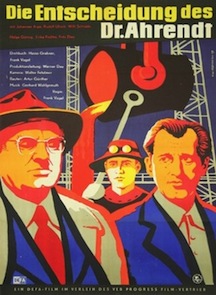 Film making that is directed by government officials, as happened throughout the Soviet bloc, is fairly certain to have glaring shortcomings — not that being directed by market forces has always served Western studio output well, either, as much sclerotically righteous output attests.
Film making that is directed by government officials, as happened throughout the Soviet bloc, is fairly certain to have glaring shortcomings — not that being directed by market forces has always served Western studio output well, either, as much sclerotically righteous output attests.
The military henchmen required that dramas be made according to guidelines intended to insure uplifting socialist inanities, whether cruel or merely ideologically infantile. And yet, audiences came, cinemas multiplied, and distributor Progress Film Vertrieb met the demand by augmenting local fare with films from 30 countries.
The posters come from a broad span of years, and reflect changes of style and aesthetic — broadly, from realistic depictions in the 1950s, to increasing stylization and abstraction through the 1970s. Censorship increased with construction of the Berlin Wall in 1961, and yet artists continued to find effective means of expression. That dissipated from the mid-1980s, with the rise of “Glasnost” under Soviet premier Mikhail Gorbachev, culminating in 1989 with the fall of the Berlin Wall, and then in 1990 the reunification of Germany.
Of their nature, film posters were intended for short-term use; in East Germany, the quality of paper used was low, to begin with, so many of the posters were fragile, even at the time they were created.
Nonetheless, the George Mason University collection has some gems: one poster is for the 1965 East German pro-democratization film The Rabbit is Me, which the country’s rulers banned as “anti-socialist.” Another is for Dein unbekannter Bruder (Your Unknown Brother), a 1982 feature about a communist confused about whom he can trust as Nazism intrudes into the German political landscape. The film drew a Cannes Film Festival nomination before DDR officials withdrew it — and then set about obstructing director Ulrich Weiss‘s career.
A third poster in the collection is for Jacob the Liar, which East German authorities declined to release for distribution after it won a 1975 Academy Awards nomination. It did not appear until 1989, when the Berlin Wall fell.
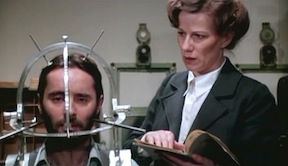
In the 1982 film, Dein unbekannter Bruder (Your Unknown Brother, the hero starts to get a clearer sense of whom he can and cannot trust.
Most of the films publicized with posters in East Germany were imports from other Soviet Bloc countries, but plenty were for non-East German and even non-East Bloc films that censors allowed deemed promoted socialist concepts. One is for Trading Places, American director John Landis facile capitalism-is-fickle tract about two wealthy market manipulators who suffer a fall from fortune that a former employee orchestrates in league with a homeless black man, played by Eddie Murphy.
Prominent among the artists represented on the posters are Manfred Butzmann, Wolfgang Janisch, Volker Pfuller, and Hubert Riedel. An article in an internal George Mason University magazine explains that “some of the posters from the late 1940s and early 1950s reflect Socialist Realism, the form of art encouraged at the time. Socialist Realism was intended to depict the benefits of living and working in East Germany. However, influences from the West led to the formation of several underground groups whose members wanted to express themselves in more creative ways.”
Thomas Hill, the German-born commercial collector and dealer who sold the collection to George Mason University, is credited with holding one of the world’s largest private poster collections, with particular strengths in film and theater. Formerly based in Amsterdam, he now works from England.
His interests are eclectic, but with emphases on the counterculture of the 1970s and beyond: human rights, peace movements, environmentalism, socialism, communism, the developing world, green parties, globalization, anti-racism, anti-fascism, anti-apartheid, student movements, the events in Paris of May 1968, workers rights, feminism, migration, ethnic conflict, poverty, charity, solidarity, Esperanto, nuclear energy protest, animal rights, nature conservation, voting rights, gender and sexuality, labor unions, anarchism, civil rights…
 He has sold posters not only to George Mason University, but also to the U.S. Library of Congress and to Harvard University. The former has some 9,000 political posters Hill collected, while the latter’s Widener Library has a Thomas Hill Collection that is being digitized, and that can be browsed via thumbnails (larger reference images can be viewed only by Harvard employees and students).
He has sold posters not only to George Mason University, but also to the U.S. Library of Congress and to Harvard University. The former has some 9,000 political posters Hill collected, while the latter’s Widener Library has a Thomas Hill Collection that is being digitized, and that can be browsed via thumbnails (larger reference images can be viewed only by Harvard employees and students).
About half the Harvard collection’s 6,000 posters document the history of the former Soviet occupation zone and East German state from the aftermath of WWII through the first democratic elections following German Reunification. (The other posters in the collection relate to AIDS awareness and prevention campaigns around the world.)
Hill has sold film posters to Georgetown University, too — 322 Cuban film posters, in the late 2000s, as well as 150 related to German opera, theater, cabaret, and performance to the Wende Museum in Culver City, California.
To Cornell University, Hill has sold thousands more of the AIDS-campaign posters he has collected from 45 countries, including 16 in Africa; and then thousands more posters used for promotion of pop and rock music bands of 1970-2006 in England, Germany, Denmark, and elsewhere in Europe. He has placed AIDS-related posters with the Wellcome Library in the U.K., too.
Despite how many posters Hill has released for purchase, he still numbers his collection at around 100,000 posters from more than 150 countries, most relating to political and social issues, and to the performing arts. He still holds 5,000 film posters with an emphasis on Eastern Europe, especially Poland. He has about 50 silent-movie posters dating from 1912 to 1914. (More on Thomas Hill, in these pages, on another occasion; for now, back to George Mason’s East German hoard.)
 Part of George Mason librarians’ rationale for making the purchase from Hill was that students could view the posters in connection with a variety of courses, whether in history, art, film, or other areas. “One of the big things going on at this university and many others is getting undergraduates doing primary-source research — to come to special collections and get introduced to that type of scholarly activity, early on,” says Jordan Patty, the special-collections librarian. Scholars from on campus or from afar have used the material, too. To make that easier, Patty says, he and his colleagues are now looking for sources of funding that would permit them to digitize the collection and place it online with the usual copyright stipulations.
Part of George Mason librarians’ rationale for making the purchase from Hill was that students could view the posters in connection with a variety of courses, whether in history, art, film, or other areas. “One of the big things going on at this university and many others is getting undergraduates doing primary-source research — to come to special collections and get introduced to that type of scholarly activity, early on,” says Jordan Patty, the special-collections librarian. Scholars from on campus or from afar have used the material, too. To make that easier, Patty says, he and his colleagues are now looking for sources of funding that would permit them to digitize the collection and place it online with the usual copyright stipulations.
He and his colleagues have been conferring on those with managers of the extensive DEFA Film Library at the University of Massachusetts at Amherst who have cleared copyright obstacles sufficiently to permit their online-access subscription collection.)
Stanford University has many posters in its library collection that it has digitized and catalogs with online thumbnails. To cater to copyright issues, librarians have posted a statement inviting objection from any copyright holders who would like even the thumbnails removed.
Because the East German film industry was very active, and so strikingly represents a gloomy period of European history, it now is attracting a good deal of interest from historians and film scholars and enthusiasts, Jordan Patty notes.
Consideration of the East German experiment has been active in various disciplines, not all blessed with the sort of outlandish subject matter as film studies. Among the films that are the subjects of posters are some local and imported doozies.
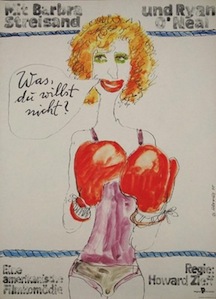 There’s one, for example, for Die Entscheidung des Dr. Ahrendt (1960, Dr. Ahrendt’s Decision), one of many DEFA-commissioned “mission films” of the late 1950s and early 1960s that were supposed to advance political aims. In it, Frank Vogel of East Germany developed a portrait of an iron-smelter innovator, Dr. Ahrendt, whose meets disparagement of his loyality when his invention falters. He and his fellow factory workers persist, and prevail.
There’s one, for example, for Die Entscheidung des Dr. Ahrendt (1960, Dr. Ahrendt’s Decision), one of many DEFA-commissioned “mission films” of the late 1950s and early 1960s that were supposed to advance political aims. In it, Frank Vogel of East Germany developed a portrait of an iron-smelter innovator, Dr. Ahrendt, whose meets disparagement of his loyality when his invention falters. He and his fellow factory workers persist, and prevail.
Vogel elsewhere in his career made indifferent films with “horribly wooden scripts” about women who must choose between “a flashy yet unworthy suitor embodying Western values and a sincere and caring rival standing for the new society,” as Joshua Feinstein put it in The Triumph of the Ordinary: Depictions of Daily Life in the East German Cinema, 1949-1989 (UNC Press, 2009).
Feinstein notes, too, that Vogel, despite his gift for tedium, managed to perturb the regime’s apparatchiks by commenting on one occasion that reading the Soviet daily Pravda left him “upbeat, happy, and optimistic,” while the local politrag Neues Deutschland, often angered him. A party official said at a DEFA meeting that “the struggle against schematicism, dogmatism, and superficiality can easily ally itself with unprincipled liberalism and open revolt against the Party’s cultural policy.” (Again, you could apostrophize about the grinding nature of a film aesthetic that could generate claptrap like that, but then you’d probably also want to flip though some Hollywood studio bosses’ earnest-drivel pronouncements, for balance.)
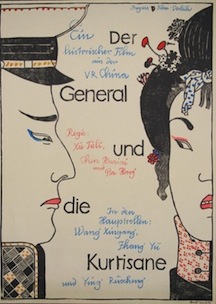
From China, DEFA acquired Der General und Die Kurtisane (The General and the Courtesan), a 1984 military drama by Xie Fieli, Chen Huaiai, and Ba Hong starring Wang Xingang, Zhang Yu, and Ying Ruocheng.
Apparently Vogel ran with the humor, because in 1961 he made Der Mann mit dem Objectiv (The Man with the Lens) which, Feinstein says, boasted the comic premise of “a time traveler from a future socialist utopia who visits the GDR and is shocked by its backwardness.”
But Vogel returned to disfavor a few years later, at the Eleventh Plenum, a notorious pow-wow where regime big-cigars “launched a scathing attack on artists, singling out the DEFA feature film studio for especially harsh criticism,” says Feinstein. The party banned 12 films during the following nine months; their offense: artistic accomplishment amidst political provocation.
Feinstein writes that the barred films affronted sensitivities because they erred from DEFA’s standard output, which “tended toward either facile propaganda or genre films.”
Among the offenders was Vogel’s Denk bloss nicht, ich heule (Just Don’t Think I’ll Cry, 1965) which disparaged East German society as violent and angry. It featured “a self-styled Halbstarker (punk) who was precisely the type of rebellious delinquent that officials at the Eleventh Plenum had in mind when they warned against the corrupting influence of Western culture.”
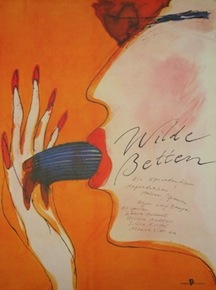 When Ossi naughtyboys turn to James Dean as their style icon, you know they goin be trouble, and Vogel presents that à la On the Waterfront: “Generational conflict climaxes in a brutal beating amid the ruins of a Nazi ceremonial edifice,” Feinstein notes.
When Ossi naughtyboys turn to James Dean as their style icon, you know they goin be trouble, and Vogel presents that à la On the Waterfront: “Generational conflict climaxes in a brutal beating amid the ruins of a Nazi ceremonial edifice,” Feinstein notes.
Men being men wherever they prowl, DEFA finally figured out that tits-n-arse slapper flicks would be safer bets, and so imported for the volks’ uplift, after a couple of years of ideological vetting, Luigi Zampa’s 1979 sexxy-symbol comedy, and last hurrah, Tigers in Lipstick, titled Wilde Betten for the local wild beastyboys. The film’s eight comic sketches set around Italy featured leading 1970s European ladies-of-libido including Ursula Andress, Laura Antonelli, and Sylvia Kristel.
Thus did the Stazi surveillance state, where every citizen was by default bound to perv, lay abed with capitalist vaseline-lensed commodification of free-market flesh.
In a book that appeared in June 2014, DDR Posters: The Art of East German Propaganda (Prestel), David Heather writes in his introduction that the history of the medium “sheds some light on the way the state influenced the thinking of the people through the medium of the poster and how the DDR evolved.”
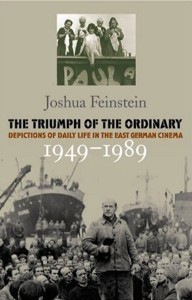 The posters were “based on the premise that ‘Propagandizing the ideas of Marxism-Leninism and tirelessly explaining the policies of the party to the broad masses was one of the most important activities of the party.’”
The posters were “based on the premise that ‘Propagandizing the ideas of Marxism-Leninism and tirelessly explaining the policies of the party to the broad masses was one of the most important activities of the party.’”
Artists, even those who had worked for the Third Reich, were able to find valued positions within this grand project by adapting to party demands.
Heather writes: “Early work of artists in the area under Soviet influence focused on Allied communication on such issues as the prevention of looting, theft from work, the warnings against the vibrant black market economy, and those related to health.”
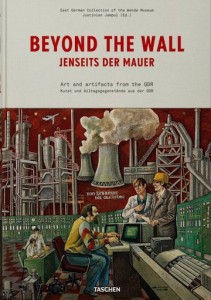 Within the Sowjetische Besatzungszone (Soviet Occupation Zone), and from 1949 within the new DDR (East Germany), the art of propaganda reflected Soviet styles as artists learned the messages of Communism — at their core, versions of “To learn from the Soviet Union is to learn victory” — and shaped them for a German population.
Within the Sowjetische Besatzungszone (Soviet Occupation Zone), and from 1949 within the new DDR (East Germany), the art of propaganda reflected Soviet styles as artists learned the messages of Communism — at their core, versions of “To learn from the Soviet Union is to learn victory” — and shaped them for a German population.
In doing so, Heather writes, the artists merely adopted the skills they had learned in their studies, as early as before World War I, and that they had then shaped through the demise of the Weimar Republic, the era of hyperinflation, and the rise of National Socialism. The rebuilding phase after World War II saw artists shape messages of working together, helping war widows and their children, reforming agriculture to overcome severe food shortages, and ensuring that the horrors of Nazism would never recur.
They learned easily enough to disparage the United States, Britain, and France, particularly the U.S. which in contrast to European allies rejected any embrace of the social-support ethos of socialism.
— Peter Monaghan
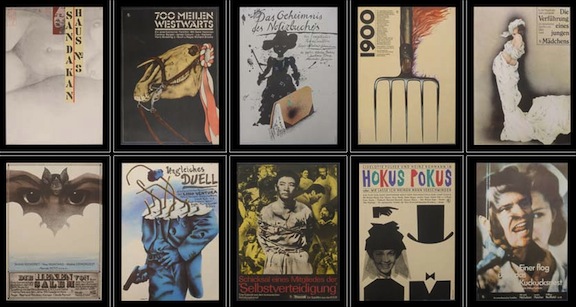
A selection from Thomas Hill’s commercial East German film-poster collection.
Printed from Moving Image Archive News: http://www.movingimagearchivenews.org
URL to article: http://www.movingimagearchivenews.org/10877/
Click here to print